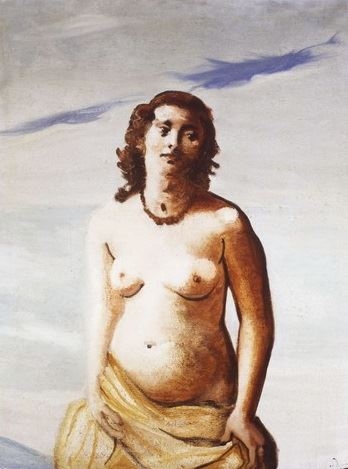
STAAND NAAKT / STANDING NUDE
André Derain
- ca 1925, olieverf op doek
116 x 89 cm
Nadat André Derain bekend was geworden om zijn fauvistische en kubistische schilderijen, werd zijn schildertrant in de jaren twintig traditioneler. Door een reis naar Rome werd zijn interesse voor de klassieke kunst gewekt. Daarmee sloot hij aan bij het retour à l’ordre: een tendens tot classicisme die in de jaren twintig populair was in de Europese kunst.
Dit Staand naakt is monumentaal geschilderd in frisse, maar bescheiden kleuren. Aan het schilderij is te zien dat Derain belangstelling had voor beeldhouwkunst. Alle aandacht gaat uit naar het model, de achtergrond lijkt geen rol te spelen. De dikke contourlijnen accentueren de sculpturale vormen van het model. De monumentaliteit wordt benadrukt doordat we van een laag standpunt naar de vrouw opkijken.
Bijzonder is het gezicht van de vrouw. Dat is niet alleen geïnspireerd door de klassieke beeldhouwkunst. Het lijkt ook een aankondiging voor de beelden die hij later gaat maken: kopjes die eenzelfde plastische vormentaal hebben en die werden beïnvloed door Afrikaanse plastieken. Dirk Hannema zag dit schilderij in 1936 bij kunsthandel d’Audretsch in Den Haag, samen met een buste van Despiau. Omdat hij toen niet het geld had om ze te kopen, ruilde hij een maanlandschap van Jongkind in om ze toch te kunnen verwerven.
C. 1925, Oil on canvas
116 x 89 cm
Having become known for his fauvist and cubist work, in the 1920s André Derain adopted a more traditional style. His interest in classical art was sparked by a trip to Rome, and he joined the retour à l’ordre, the trend towards classicism that was popular in European art in the 1920s.
This Standing Nude is a monumental painting rendered in fresh yet restrained colours. The painting reflects Derain’s interest in sculpture. All attention is focused on the model; the background is apparently of no consequence. The thick contour lines accentuate the sculptural forms in the model. The monumentality of this work is emphasised by the low perspective from which we view the woman.
The face of the woman is extraordinary. Inspired not only by classical sculpture, it also seems to be a precursor to the sculptures Derain would later go on to make, heads featuring the same plastic form language, which were influenced by African figures. Dirk Hannema saw this painting at d’Audretsch art dealers in The Hague in 1936, along with a bust by Despiau. He did not have the money to buy them, however, so he exchanged a moon landscape by Jongkind for the two works.
André Derain
* 1880-06-10
† 1954-09-10